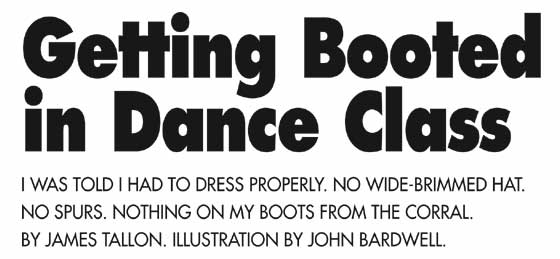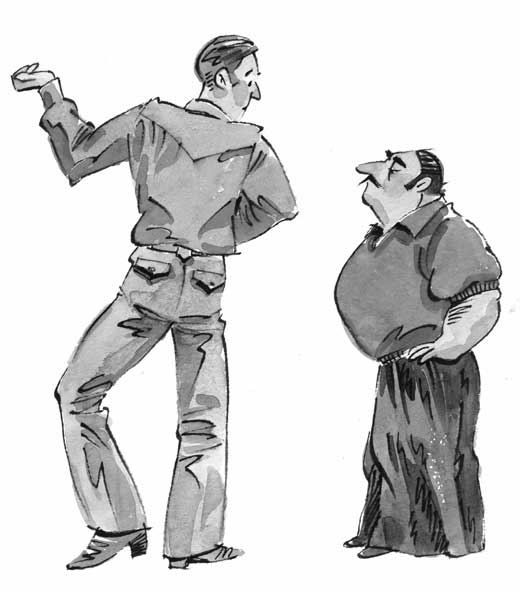|
|
|
| Subscriptions click here for 20% off! | E-Mail: info@rangemagazine.com |

|
. All my past and potential dancing partners will be agonized, in more ways than one, to learn I have dropped out of my Phoenix ballroom dance class. Blame that on our instructor, Enrico. He insulted me. It came about when I made a little non-foxtrot whirl with one of the overabundance of women in the class. She said, “Isn’t that country and western?” Well, it really wasn’t. I had picked it up from Gene Kelly while he was dancing in the rain. Before I could reply, Enrico promenaded up and said, “Of course it is, see the way he is dressed.” It wasn’t what Enrico said, but the way he said it. I could not shake the clothing styles of my Grand Canyon guide and Northern Arizona cowpunching days and
was wearing denim pants and western long-sleeve shirt, freshly washed and pressed and neat and clean, and with Levis being the only prominent logo, and a pair of $75 mule-hide cowboy boots, polished, nothing on them from the corral. No spurs. No wide-brimmed hat. (See Note 1) When I was signing up for the class, a notice on the wall said to dress properly. I was dressed properly, I thought, and that was confirmed for me when a fellow student told me they just didn’t want anyone bouncing around the gymnasium, presently allocated for dance class, wearing sweatshirt and shorts. Next, a lady asked me if I could dance in cowboy boots and I replied that having spent 30 years dancing in them, I couldn’t dance without them. Just like the flamenco dancing of the Andalusian Gypsies, you know, the ones who stomp their high heel boots expeditiously on the floor. Though dance class tunes like Allegheny Moon aren’t exactly conducive to any spectacular heel stomping or, for that matter, staying awake. Without extensive searching, cowboy boots are the only footwear I have been able to find made in modern times that have leather soles, which are so necessary for gliding across dance floors. Cowboy boots were originally designed for getting on a horse quickly and when being tossed from one quickly, to reduce the potential of your feet slipping through the stirrups and being dragged through and damaging the environment. This clarification is in case many of the celebrities appearing on talk shows wearing cowboy boots have forgotten. Toes on cowboy boots are narrow and heels high—on custom-made boots, very high. Mine are just two inches. They take my five feet, eight inches right up there with Batman—er, Michael Keaton. The extra height prevents certain stately ladies I have danced with from resting their chins on top of my head, which is a good way to lose a tooth or get a bloody nose when they dance with me. That is, if I fail to jump high enough when I spin them. Actually, in Enrico’s dance class I felt dressed pretty formal as you can get elected to the Senate or House of Representatives or other governmental offices by politicking in western clothes. A former Republican president was frequently seen in western dress, and not always in the West. At Oklahoma State University at Stillwater, I showed up for a one-week seminar dressed Arizona-western to find the class full of elite people wearing expensive suits and real ties. No mad-rags (neckerchiefs). Having always wanted to appear elite myself I showed up the next day in suit and tie to find most of the assembly had gotten into their denims and cowboy boots, and those who hadn’t brought them were showing signs of embarrassment. Not a tie other than mine was in sight. On SS Universe, a cruise ship to Alaska, nobody made uncomplimentary tonal insinuations about my western outfit, and on ladies night I was very much in demand as a dancer. Most wanted to know what part of Texas I was from and how many cows and oil wells I owned, and if Ann Richards rolled her own Bull Durham cigarettes as many cowmen and cow-ladies still do to this day. All my life I have attended Gene Kelly and Cyd Charise, and Fred Astaire and Ginger Rogers-type musicals (and now watch reruns on TV), including the more modern ones like “All That Jazz.” Sometimes I would pick up a step or two from these films and give them a little western touch. If you saw Henry Fonda playing Wyatt Earp in “My Darling Clementine,” you know the dance style I like most. I have toned down that fancy backward right-leg kick Fonda did, as I don’t want to cripple anyone behind me. My teacher, Enrico, was abhorrently dressed in a short-sleeve maroon golf shirt, a pair of Charlie Chaplin pants which looked rescued from a dumpster and, well, I don’t know about his shoes as they were black and scuffed with much use. I suppose that’s the way dance instructor’s shoes are supposed to look. Anyway, judging by the way Enrico made those fast little spins like Gene Kelly and I do, I can only assume that he went to a boot maker to find leather and have his shoes resoled. Certainly, dressed as Enrico dresses, in places I have danced across Arizona— Prescott, Payson, Flagstaff and Tusayan near Grand Canyon, for example—he would have been called a “dude” when “dude” meant “dude.” The bartender, concerned for the intact mirror and bottles behind the bar and his newly rebuilt tables and chairs, would have put an arm around Enrico, taken him to one side and said, “Sit in that dark corner over there and you can stay. Whatever you do don’t get up in that getup and start dancing.” That is, unless Enrico bought a round and explained he had just been robbed, his regular clothing and his horse stolen. Even today on Saturday night it may still be dangerous for Enrico in dance halls in those towns mentioned above, including haunts like Bird’s Oak Creek Tavern in Sedona, which mostly cater to a patronage totally ignored by cowboy-conscious German, Frenc+ and Japanese tourists and photographers. Enrico is from New York City they tell me and I’ve been told there’s a tendency for New Yorkers to be a bit more curt than us westerners. But those I personally met in New York were polite and accommodating, and clerks behind the deli counter whispered tips like not to order the potato pancakes. In a small restaurant, the owner eyed our western accoutrements and insisted on paying for our breakfasts. Actually, I once qualified as a skilled ballroom dancer, thanks to the Fred Astaire Studio in Tucson. (Even took a little tap dancing but gave it up as my left foot was learning faster than the right, messing up my coordination.) No teacher, or the clerks who took my money, even mentioned or appeared to take note of my Arizona-western apparel. Despite big windows in the front of the building which allowed anyone to look in and see my mistakes, and sometimes the body contact with lovely young-lady teachers required to add real pizzazz, I learned fox trot, waltz, jitterbug (sometimes called swing or lindy), and all the Latin dances except mambo and salsa. I especially liked Latin dances, and with considerable training in my feet and hips, I took a trip to Guaymas to find in the clubs there dancers only danced the mambo. Later, in Costa Rica, I found only the salsa. I became so good at ballroom dancing that the only partners who could dance with me without being severely injured were the ladies at Fred Astaire Studios, who taught me. Even Terpsichore might have stepped on my toes. To become more flexible, I took a dance class at the downtown branch of the YMCA in Phoenix—$17 as opposed to hundreds of dollars for the Fred Astaire training. In a few weeks I was completely debriefed, and afterward, I could dance with just about anybody, though I stayed with the ladies most who broke the ice by admiring my western dress. Unlike riding a bicycle, you can forget dance steps so 20 years after the fact I decided I needed a refresher, and that’s how I wound up in Enrico’s class. Enrico probably meant nothing by his snippet, perhaps just a try at being witty, not knowing there’s a difference between eastern witty and western witty. Maybe I should have attempted wit myself. I could have said I was sharpening my choreography for a masquerade ball. James Tallon is a writer-photographer, tango partner and guacamole expert from Phoenix, Ariz. To explain “Note 1” he says, “My mother taught me it shows disrespect for a lady when a man wears a hat while dancing with her. Wearing a cowboy hat while dancing was started at Tusayan, Ariz. by Muleskinner Frank Blumlein, who was balding and who looked 10 years younger with a hat on. It was then picked up by other men who were balding or already bald and desperately needed to look 10 years younger. Note western line-dancing on TV. All men not wearing cowboy hats have hair.” |
|||
|
Spring 2003 Contents To Subscribe: Please click here or call 1-800-RANGE-4-U for a special web price Copyright © 1998-2005 RANGE magazine For problems or questions regarding this site, please contact Dolphin Enterprises last page update: 03.29.05 |
|||

